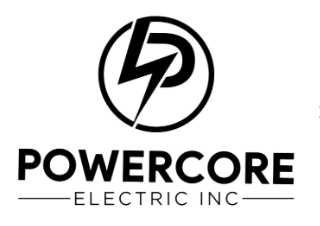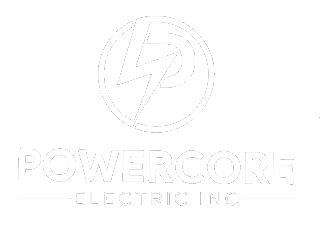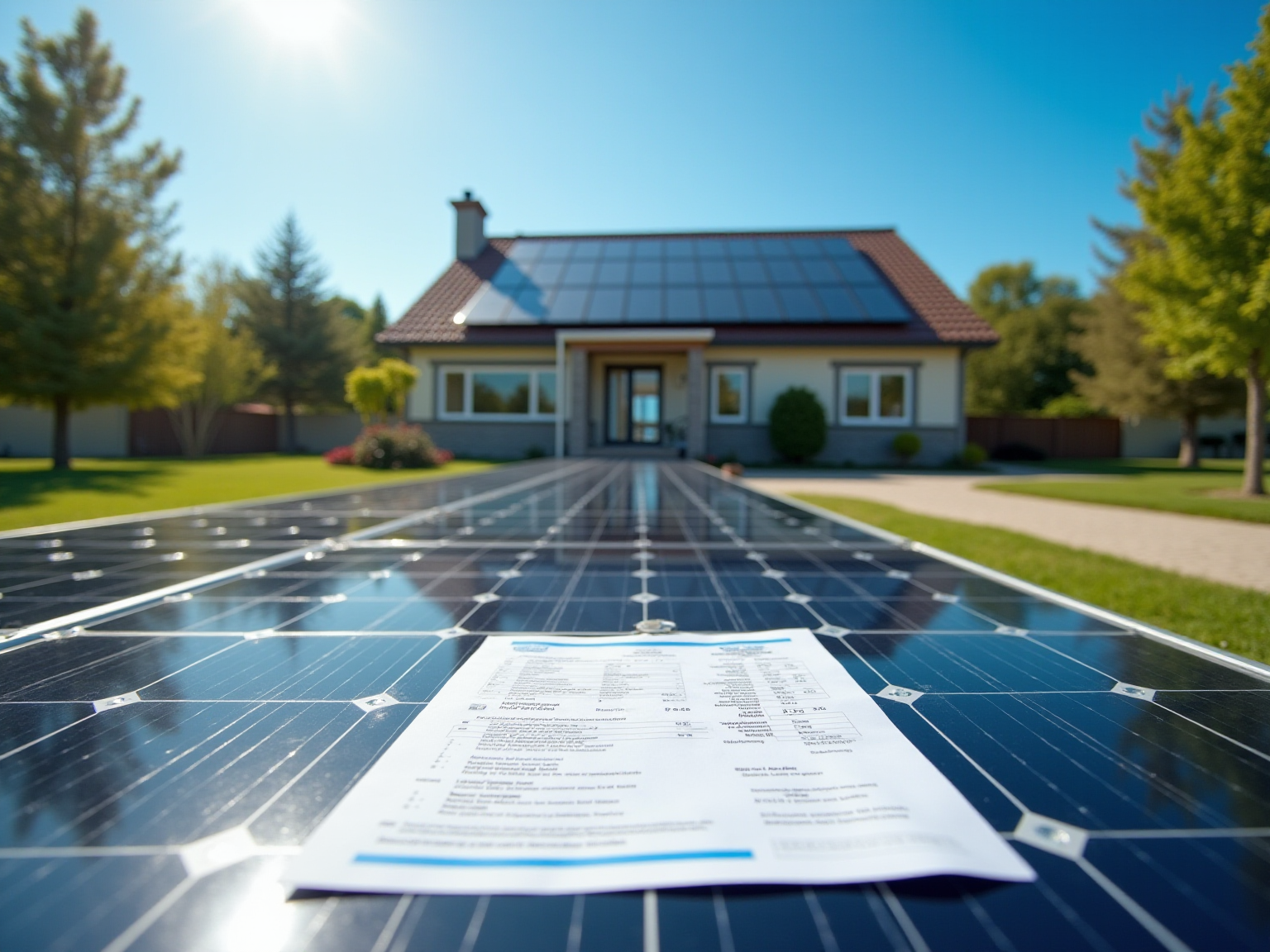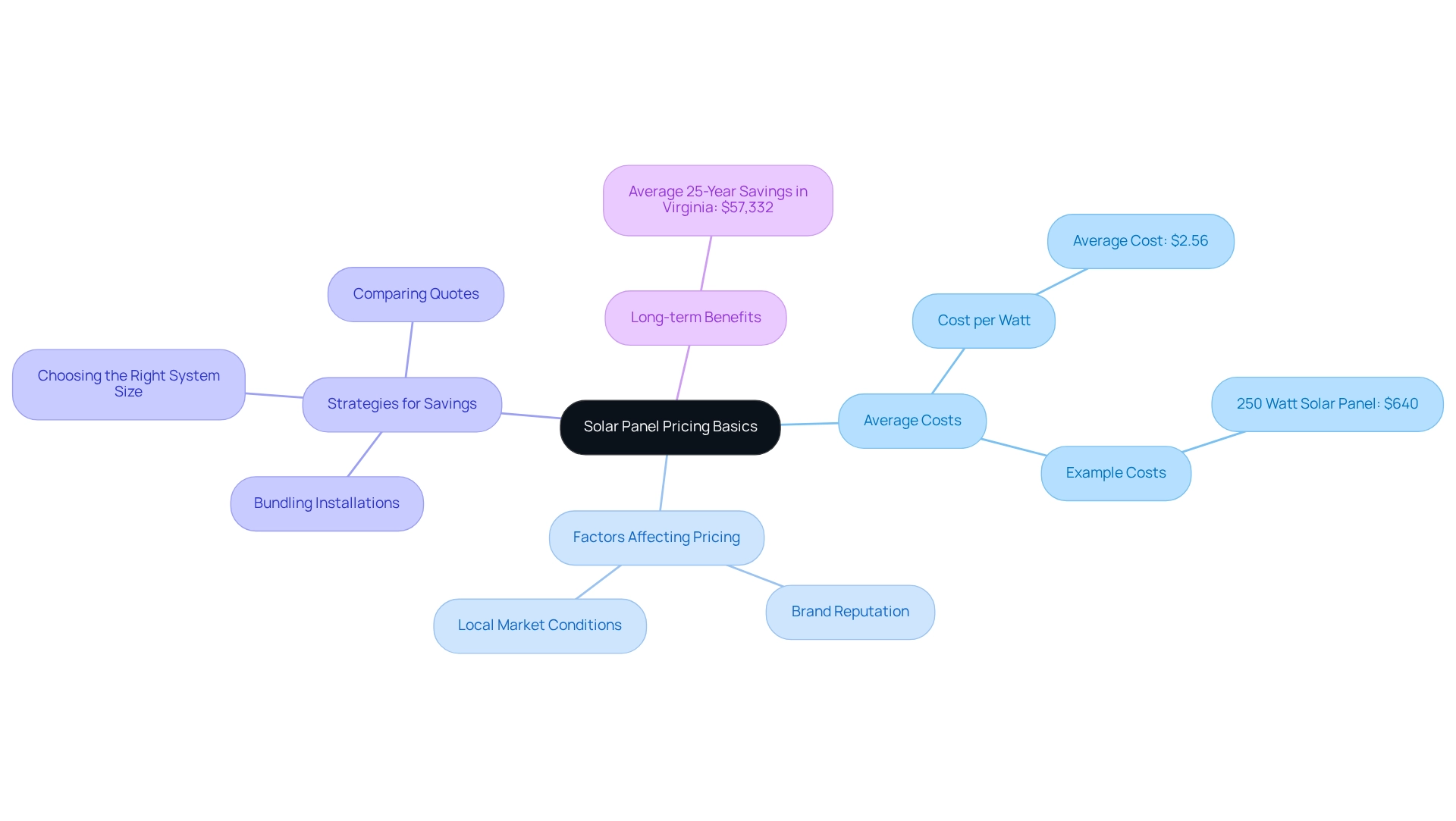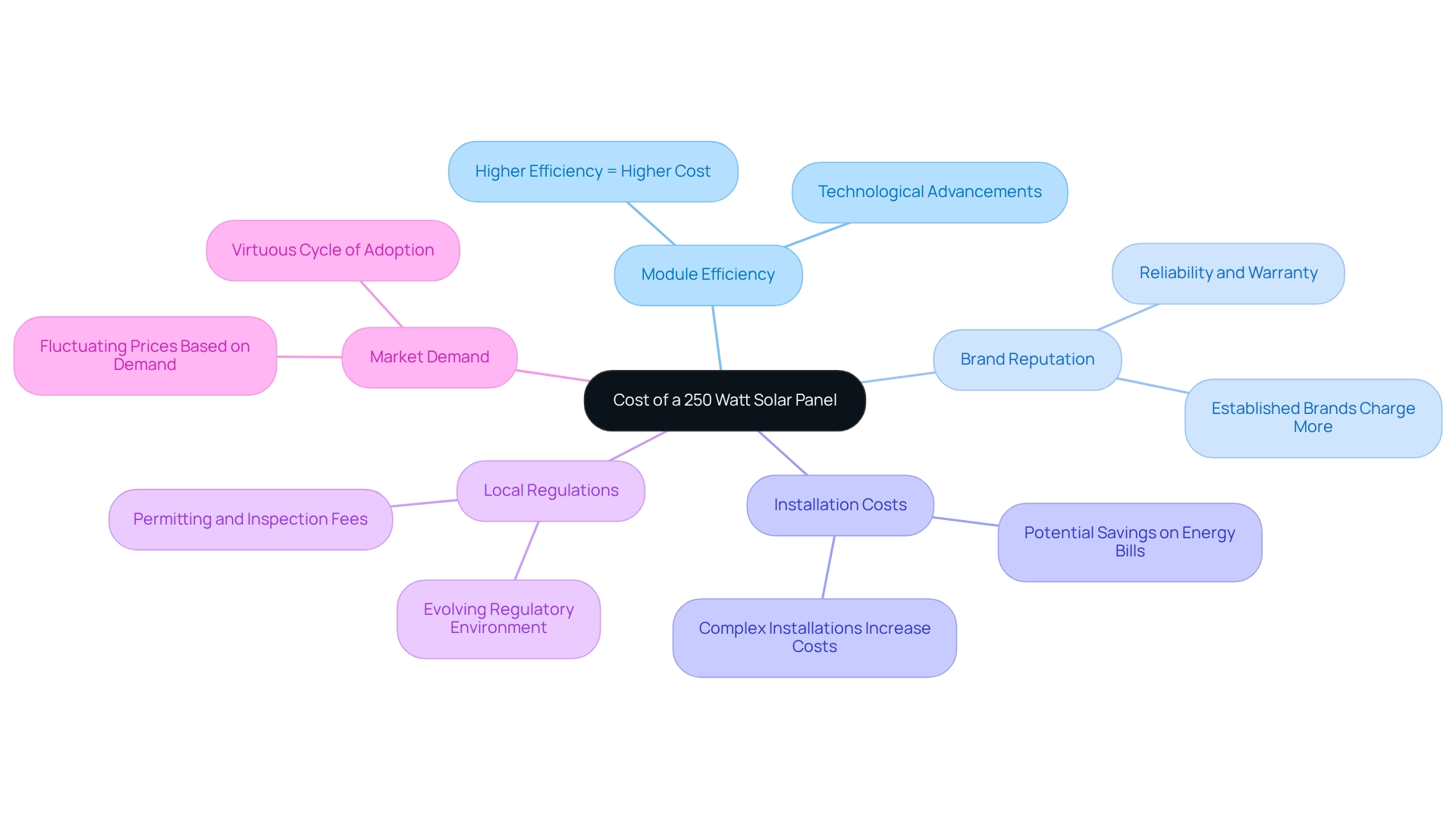Overview
We understand that managing energy bills can be a significant concern for many homeowners. The average cost of a 250-watt solar panel is approximately $640, and when you factor in installation and additional expenses, the total can reach around $2,640. This pricing is influenced by various factors, including:
- Brand reputation
- Installation complexity
- Local regulations
- Market demand
Together, these elements are discussed in the article to provide you with a comprehensive understanding of solar panel investments. By exploring these details, we hope to highlight the benefits of solar energy and the potential for energy independence, reassuring you that you are making a meaningful choice for your home and community.
Introduction
As you face the rising costs of energy bills, we understand that finding a sustainable solution can feel overwhelming.
Solar panels have emerged as a promising option for homeowners like you who wish to reduce both energy expenses and their carbon footprint.
With the average price of solar panels steadily decreasing, many are eager to explore the financial implications of this transition.
However, navigating the complexities of solar panel pricing can be daunting. From understanding the cost per watt to identifying critical factors that influence installation expenses, it’s common to feel uncertain.
That’s why arming yourself with knowledge is essential for making informed decisions.
This article delves into the essentials of solar panel pricing, the various components that contribute to the overall cost, and the financial incentives available to make solar energy more accessible than ever.
Together, we can explore how embracing this change not only benefits you but also contributes to a more sustainable future.
Understand the Basics of Solar Panel Pricing
Are you feeling the pinch of rising energy bills? You’re not alone. Many homeowners are searching for solutions to manage their electricity costs, and solar energy might just be the answer you’ve been looking for. In 2025, the average expense per watt for photovoltaic systems stands at approximately $2.56, which raises the question of how much does , totaling around $640. It’s important to note that prices can fluctuate based on factors such as brand reputation, efficiency, and local market conditions.
We understand that the cost-effectiveness of solar systems has significantly improved, particularly in regions with high electricity rates. This makes renewable energy an increasingly attractive option for homeowners. For instance, in Stockton, California, local companies offer tailored solutions to help you find the best panels for those cloudy days, ensuring you get optimal power output even when the weather isn’t cooperating.
Moreover, with the average grid electricity cost rising by 18% over the past two years, more people are turning to renewable energy to combat escalating energy expenses. As highlighted by Solar.com, this trend underscores the need for homeowners to explore renewable options. To maximize your savings, consider strategies like:
- Bundling energy system installations with other home improvements
- Selecting the right system size
- Comparing multiple quotes
Understanding residential photovoltaic sizes is crucial, especially under the 200% guideline, which can greatly impact the benefits and effectiveness of your energy investments. According to a case study titled ‘Additional Ways to Save on Solar Panels,’ implementing these strategies can lead to significant savings and a more efficient energy investment.
However, it’s essential to be cautious of misleading advertisements that claim free photovoltaic panels, as these are often scams. By grasping these pricing fundamentals, you can make informed decisions when evaluating renewable energy options, such as understanding how much does a 250 watt solar panel cost. Remember, the average 25-year savings for photovoltaic systems in Virginia is an impressive $57,332, highlighting the long-term financial benefits of investing in renewable energy. Together, we can work towards a more sustainable and cost-effective future for your home.
Identify Key Factors Affecting the Cost of a 250 Watt Solar Panel
Are you feeling overwhelmed by rising energy bills? You’re not alone. Many homeowners share this concern, and it’s understandable to seek solutions that not only alleviate financial stress but also contribute to a sustainable future. One effective way to address this issue is by considering the installation of a solar energy system, particularly understanding how much does a 250 watt solar panel cost, as the price is influenced by several key factors that can help you make informed decisions, such as module efficiency, where higher efficiency modules convert more sunlight into electricity and often come with a higher price tag. However, advancements in technology have improved efficiency, making these units more appealing despite their increased cost. The U.S. Energy Information Administration notes that expenses for have decreased by over 70% since 2010, highlighting how technological progress impacts pricing. This is particularly relevant for homeowners in Stockton, California, who may be looking for options that perform well even on cloudy days.
- Brand Reputation: Established brands typically charge more due to their perceived reliability and strong warranty offerings. Investing in products from companies with a proven track record in renewable energy can provide peace of mind. Local energy companies in Stockton can offer valuable insights into the best brands available in the market.
- Installation Costs: The complexity of the installation process can significantly affect overall expenses. For instance, roofs requiring additional structural support or specialized mounting systems will lead to higher labor costs, impacting your total investment. It’s also essential to consider the economic advantages of investing in photovoltaic systems, such as potential savings on energy bills and eligibility for government programs that can help offset installation costs.
- Local Regulations: Variations in permitting and inspection fees across different regions can influence the total installation cost. Being aware of local regulations that may add to your expenses is crucial. As the share of total U.S. electrical generation from renewable energy has risen from 0.1% in 2010 to over 6% today, the evolving regulatory environment can further affect costs.
- Market Demand: The demand for photovoltaic modules can fluctuate, leading to price adjustments. Areas with high adoption rates may see rising prices due to increased demand, while competitive markets may lower costs. This virtuous cycle of harnessing sunlight illustrates how increased panel production leads to declining costs, further accelerating adoption and making this energy source more accessible for consumers, especially when considering how much does a 250 watt solar panel cost, which empowers you to make informed choices and effectively budget for your solar panel investments. Moreover, exploring alternatives like and battery solutions can enhance energy efficiency and sustainability in your home. As the energy market evolves, staying informed about these dynamics is essential for maximizing your value. Together, we can navigate this journey towards energy independence and a more sustainable future.
Calculate the Total Cost of a 250 Watt Solar Panel Installation
Are you feeling the weight of rising energy bills? You’re not alone. Many homeowners are exploring sustainable solutions like solar energy to not only reduce costs but also to gain energy independence. To help you understand the financial investment involved in installing a 250-watt solar panel, let’s break down the key components together:
- To determine how much does a 250 watt solar panel cost, it is on average around $640.
- Installation Expenses: Depending on how complex the installation is, costs can vary from $1,000 to $3,000. For our example, we’ll assume an installation expense of $1,500, which is quite common.
- Additional Costs: This includes permits, inspections, and any necessary upgrades to your electrical system, which can add approximately $500.
Total Cost Calculation:
- Panel Cost: $640
- Installation Cost: $1,500
- Additional Costs: $500
Total Installation Cost = $640 + $1,500 + $500 = $2,640
This total gives you a clearer picture of the financial commitment required for . It’s important to consider that factors like your roof’s condition and pitch can significantly impact and efficiency. For example, roofs with a lower pitch and easier access usually incur lower installation costs. Therefore, evaluating your roof’s suitability is essential before moving forward.
Moreover, transitioning to renewable energy is a journey that typically spans two to three months. This period encompasses planning, permitting, and installation, allowing for careful preparation and execution. As Robert Tschudi, a specialist reviewer, notes, “In most instances, photovoltaic systems are included in homeowners insurance,” which is an important financial consideration for property owners. Additionally, the slope of your roof can affect the costs associated with photovoltaic systems; it’s wise to assess your roof’s state and angle prior to installation, as these elements can greatly influence both expenses and efficiency.
Together, we can navigate this path toward sustainable energy solutions, ensuring that you feel supported every step of the way.
Explore Financial Incentives and Rebates for Solar Panel Purchases
As homeowners, you may often find yourselves concerned about rising energy bills and the impact they have on your finances. The good news is that there are numerous financial incentives and rebates available when investing in solar panels, making the transition to renewable energy not only more affordable but also incredibly appealing:
- Federal Solar Tax Credit: Starting in 2025, you can take advantage of a tax credit that covers 30% of your total installation costs. This substantial incentive significantly eases the financial burden associated with installing solar panels.
- : If you’re in California, you’ll find additional rebates and tax credits, including the California Solar Initiative (CSI) and the Self-Generation Incentive Program (SGIP). These state-specific initiatives are designed to encourage the use of renewable resources, making your investment in solar energy even more financially feasible.
- Local Utility Programs: Many utility providers in California, such as Pacific Gas and Electric (PG&E) and Southern California Edison (SCE), offer rebates for photovoltaic installations or performance-based incentives that reward you based on the energy your system generates. These programs can lead to significant savings over time.
- Financing Options: Solar companies, including Powercore Electric, often present flexible financing plans, such as zero-down options and low-interest loans, allowing you to spread the cost of your solar system over time. This accessibility makes renewable energy a viable choice for a wider range of homeowners.
Moreover, you might want to consider the benefits of integrating Tesla home chargers with your photovoltaic systems, enhancing both efficiency and sustainability. Exploring battery alternatives for power storage can further maximize your solar installation’s advantages. By leveraging these incentives, you can greatly reduce your initial investment in solar systems. Over the average lifespan of a panel, which spans nine years, the potential savings can reach approximately $29,077, underscoring the long-term financial benefits of embracing this technology.
Understanding the eligibility and construction standards for the federal solar tax credit, as outlined by recent IRS guidelines, can also motivate you to invest in solar initiatives. This comprehensive approach to financial incentives not only supports you in your journey towards sustainable energy practices but also contributes to a more resilient energy future. As noted by Irma Omerhodzic, Editor in Chief, “The data was collected and used to rate and rank each state depending on the availability of the following criteria,” emphasizing the importance of being aware of state-specific incentives. Together, we can make informed decisions that lead to a brighter, more sustainable future.
Conclusion
Navigating the world of solar panel pricing can feel overwhelming, especially for homeowners who are eager to reduce their energy costs and invest in sustainable solutions. By understanding the basics of solar panel pricing—such as the cost per watt and the average price for a 250-watt solar panel—you lay a solid foundation for making informed decisions. With the average cost per watt decreasing and various factors influencing installation expenses, you can approach your solar investments with confidence and strategy.
Key factors that affect the cost of solar panels include:
- Panel efficiency
- Brand reputation
- Installation complexity
- Local regulations
- Market demand
By recognizing these elements, you can better budget for your solar installation and ensure that you make the most of your investment. Additionally, calculating the total installation cost, which includes panel price, installation fees, and any additional expenses, will provide you with a clear financial picture.
Exploring financial incentives and rebates can make solar energy even more appealing. Programs like the federal solar tax credit and various state-specific incentives can significantly lower your upfront costs and enhance the long-term financial outlook of your solar investments. As you leverage these opportunities, you can enjoy substantial savings over time, reinforcing the viability of solar energy as a sustainable choice.
In conclusion, investing in solar panels is not just a financial decision; it is a commitment to a more sustainable future. By equipping yourself with knowledge about pricing, installation factors, and available incentives, you can confidently transition to solar energy. This shift not only helps mitigate rising energy costs but also contributes to a cleaner, greener planet for generations to come. Together, we can make a meaningful impact on our environment and our wallets.
